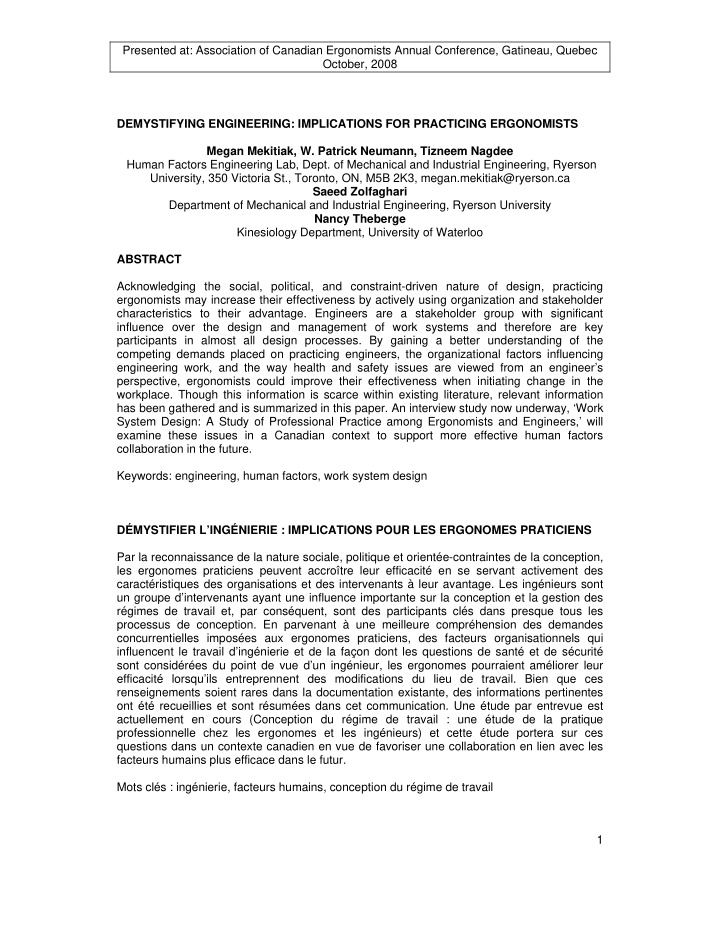



Presented at: Association of Canadian Ergonomists Annual Conference, Gatineau, Quebec October, 2008 DEMYSTIFYING ENGINEERING: IMPLICATIONS FOR PRACTICING ERGONOMISTS Megan Mekitiak, W. Patrick Neumann, Tizneem Nagdee Human Factors Engineering Lab, Dept. of Mechanical and Industrial Engineering, Ryerson University, 350 Victoria St., Toronto, ON, M5B 2K3, megan.mekitiak@ryerson.ca Saeed Zolfaghari Department of Mechanical and Industrial Engineering, Ryerson University Nancy Theberge Kinesiology Department, University of Waterloo ABSTRACT Acknowledging the social, political, and constraint-driven nature of design, practicing ergonomists may increase their effectiveness by actively using organization and stakeholder characteristics to their advantage. Engineers are a stakeholder group with significant influence over the design and management of work systems and therefore are key participants in almost all design processes. By gaining a better understanding of the competing demands placed on practicing engineers, the organizational factors influencing engineering work, and the way health and safety issues are viewed from an engineer’s perspective, ergonomists could improve their effectiveness when initiating change in the workplace. Though this information is scarce within existing literature, relevant information has been gathered and is summarized in this paper. An interview study now underway, ‘Work System Design: A Study of Professional Practice among Ergonomists and Engineers,’ will examine these issues in a Canadian context to support more effective human factors collaboration in the future. Keywords: engineering, human factors, work system design DÉMYSTIFIER L’INGÉNIERIE : IMPLICATIONS POUR LES ERGONOMES PRATICIENS Par la reconnaissance de la nature sociale, politique et orientée-contraintes de la conception, les ergonomes praticiens peuvent accroître leur efficacité en se servant activement des caractéristiques des organisations et des intervenants à leur avantage. Les ingénieurs sont un groupe d’intervenants ayant une influence importante sur la conception et la gestion des régimes de travail et, par conséquent, sont des participants clés dans presque tous les processus de conception. En parvenant à une meilleure compréhension des demandes concurrentielles imposées aux ergonomes praticiens, des facteurs organisationnels qui influencent le travail d’ingénierie et de la façon dont les questions de santé et de sécurité sont considérées du point de vue d’un ingénieur, les ergonomes pourraient améliorer leur efficacité lorsqu’ils entreprennent des modifications du lieu de travail. Bien que ces renseignements soient rares dans la documentation existante, des informations pertinentes ont été recueillies et sont résumées dans cet communication. Une étude par entrevue est actuellement en cours (Conception du régime de travail : une étude de la pratique professionnelle chez les ergonomes et les ingénieurs) et cette étude portera sur ces questions dans un contexte canadien en vue de favoriser une collaboration en lien avec les facteurs humains plus efficace dans le futur. Mots clés : ingénierie, facteurs humains, conception du régime de travail 1
Presented at: Association of Canadian Ergonomists Annual Conference, Gatineau, Quebec October, 2008 INTRODUCTION Engineers have been identified as one of the groups with a significant influence on the success of human factors application in the early phases of design and are key to successful human factors uptake in design processes (Perrow, 1983). This paper examines available information on the relationships, knowledge, and attitudes of engineers that may be relevant in improving the effectiveness of interdisciplinary human factors collaboration and introduce a new research agenda in the field of human factors engineering. HUMAN FACTORS AND DESIGN Human factors is an area of study primarily concerned with the application of theory through design (IEA Council, 2000) and the need to apply human factors in early design stages is seen as an important strategy for the prevention of work-related ill health (Ontario Ministry of Labour, 2005). Therefore, it is valuable to consider the nature of design within the organizations in which ergonomists work. Even in technical fields such as engineering, design is frequently described as a social, negotiated process between individuals who interpret the world through vastly differing mental models, philosophies and values (Broberg & Hermund, 2004; Bucciarelli, 1988, 2002). In addition, the influence of culture, from both within and outside the organization, is widely acknowledged to influence design decisions. The challenges presented by attempting to change a culture in order achieve different design results have also been documented (Broberg & Hermund, 2004; Perrow, 1983). In reaction to this interpretation of design, it has been suggested ergonomists must embrace the role of ‘change agent’ in order to maximize their effectiveness (Broberg & Hermund, 2004; Launis et al, 1996). This idea is supported by the observation that ergonomists working in the ‘change agent’ role can support application and improve adoption of HF related regulations by design engineers (Jensen, 2001; Wulff, 1999a). But in order to succeed in this role, ergonomists must learn to navigate organizations and appeal to the priorities of designers of all disciplines and levels of seniority (Broberg & Hermund, 2004; Buciarelli, 1988; Burns & Vicente, 2000). It is in this way that engineering knowledge becomes relevant to the practicing ergonomist. By gaining further insight into the goals of engineers and the constraints placed on their work, ergonomists may be able to navigate organizations more easily. ENGINEERING PRACTICE: EXISTING LITERATURE In order to investigate the current roles and responsibilities of engineers involved in work system design and their implications for practicing ergonomists, literature was reviewed across multiple disciplines. Professionals with extensive experience in human factors, industrial engineering and sociology were consulted in this endeavour. The following points were identified as relevant to human factors practitioners. Work System Design and Engineering • Workplace design is likely to be overlooked or poorly managed within organizations and there appears to be a lack of recognition of “workplace design” as a specific process or activity. (Launis et al, 1996) 2
Recommend
More recommend